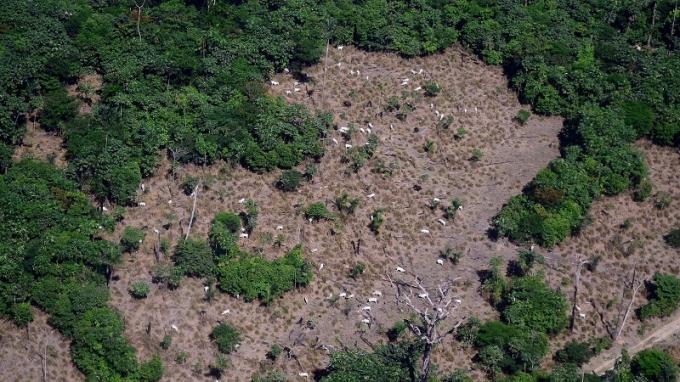Divided between the Brazilian states of Acre, Amapá, Amazonas, Mato Grosso, Pará, Rondônia, Roraima Tocantins and part of Maranhão and neighboring countries Venezuela, Colombia, Peru, Ecuador, Bolivia, Suriname, Guyana and Guyana French, the Amazon rainforest occupies about 7% of the surface of planet Earth.
This is equivalent to 6.5 million square kilometers, more than 85% of which are part of the Brazilian territory. The Amazon holds an incredible fauna and flora, estimated at 50% of the world's biodiversity.
Today, one of the main problems in the Amazon Forest is deforestation and its consequences, which impact not only Brazil, but the world as a whole. In addition to the big problem of extinction of animals and plants, the Amazon acts as an important climate regulator.
Index
- Causes of deforestation in the Amazon Forest
- Consequences
- Oversight
Causes of deforestation in the Amazon Forest
In more critical times, such as the early 2000s, it is estimated that more than 26,000 square kilometers were deforested every year. In 2018, in April alone, approximately 217 square kilometers were deforested.
And when we refer to the region, it is worth remembering that the Legal Amazon comprises all the states mentioned above, that is, more than 60% of the national territory, and not just the Amazon, a very common association because of the Name.
Some human actions are preponderant to achieve such high numbers. As you can imagine, logging is one of the main activities. Much of the degradation is caused by illegal logging, which is also illegally traded, supplying the furniture and construction industries.

Even though the region has low demographic rates, population growth causes large areas need to be devastated for cities to grow into forests to house new residents.
Last but not least are agriculture and livestock. Large areas have trees cut down or burned to make way for cattle pastures or large soy plantations. Today, it is estimated that more than 83% of deforested areas have this purpose.
These activities, in addition to deforestation, cause a series of damages to the environment. Among them, the impoverishment and compaction of soils, contamination of rivers and the water table with pesticides, in addition to the increase in the emission of polluting gases.
Consequences
After a few years in decline, deforestation in the Amazon started to grow again, according to data collected by researchers at the Amazon Institute of Man and Environment (Imazon). According to the source, between August 2016 and July 2017 the number was 40% higher than in the previous period.
- Free Online Inclusive Education Course
- Free Online Toy Library and Learning Course
- Free Online Preschool Math Games Course
- Free Online Pedagogical Cultural Workshops Course
While in April 2018 about 217 square kilometers were deforested, in the same period in 2017 the number was 97 square kilometers. Today, Mato Grosso is responsible for almost 50% of all deforestation, closely followed by Amazonas (23%), Pará (19%), Roraima (5%) and Rondônia (3%).
A worrying fact is that deforestation has reached the area known as the green belt. It crosses the states of Acre, northern Mato Grosso, southern Amazonas, part of Rondônia, to the west of Pará. Most of the logging took place in this region, where three federal highways pass.
The concern is precisely because it is an area where protection areas should be concentrated, containing deforestation and encouraging the sustainable use of forest resources.
The consequences of deforestation in the Amazon Forest are many. The extinction of fauna and flora species, as already mentioned, increased air pollution due to large fires, imbalance of ecosystems, in addition to increased erosion, since without the trees, the soil is completely unprotected.

Another big problem is related to the drop in rain levels in the tropics in regions close to the Amazon, such as Argentina, Uruguay, Paraguay and southern Brazil.
According to information from a study carried out by the University of Leeds, England, and by the Center for Ecology and Hydrology of the Council of British Environmental Research, the destruction of the forest could reduce rainfall in the Amazon by around 21% by 2050, especially during the period of dry.
In addition, an important amount of sunlight is absorbed by the trees for the process of photosynthesis and evapotranspiration, which is the combination of evaporation of water from the soil and transpiration of vegetable.
Without vegetation cover, the tendency is for the temperature to start to rise, significantly contributing to climate change.
Furthermore, deforestation is an important agent in desertification, siltation of rivers and lakes and can facilitate the transmission of pests and diseases. It also greatly alters the lifestyle of the traditional indigenous people who live in the region and are owners of a vast and rich culture.
Oversight
Since 1988 the region has been monitored by the Ministry of the Environment (MMA) in partnership with the National Institute for Space Research (Inpe). However, due to the large territorial extension, inspection policies are not always fully effective.
Much of the inspection is carried out by satellites, which quantify deforestation in areas of native vegetation, supporting actions to control and combat illegal deforestation.
From the data collected by the satellites, it is possible to measure the annual rates of deforestation, producing a geographic database, a kind of file made over the years.
The password has been sent to your email.
